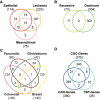Network of Cancer Genes: a web resource to analyze duplicability, orthology and network properties of cancer genes
- PMID: 19906700
- PMCID: PMC2808873
- DOI: 10.1093/nar/gkp957
Network of Cancer Genes: a web resource to analyze duplicability, orthology and network properties of cancer genes
Abstract
The Network of Cancer Genes (NCG) collects and integrates data on 736 human genes that are mutated in various types of cancer. For each gene, NCG provides information on duplicability, orthology, evolutionary appearance and topological properties of the encoded protein in a comprehensive version of the human protein-protein interaction network. NCG also stores information on all primary interactors of cancer proteins, thus providing a complete overview of 5357 proteins that constitute direct and indirect determinants of human cancer. With the constant delivery of results from the mutational screenings of cancer genomes, NCG represents a versatile resource for retrieving detailed information on particular cancer genes, as well as for identifying common properties of precompiled lists of cancer genes. NCG is freely available at: http://bio.ifom-ieo-campus.it/ncg.
Figures


Similar articles
-
NCG 4.0: the network of cancer genes in the era of massive mutational screenings of cancer genomes.Database (Oxford). 2014 Mar 7;2014:bau015. doi: 10.1093/database/bau015. Print 2014. Database (Oxford). 2014. PMID: 24608173 Free PMC article.
-
Network of Cancer Genes (NCG 3.0): integration and analysis of genetic and network properties of cancer genes.Nucleic Acids Res. 2012 Jan;40(Database issue):D978-83. doi: 10.1093/nar/gkr952. Epub 2011 Nov 12. Nucleic Acids Res. 2012. PMID: 22080562 Free PMC article.
-
NCG 5.0: updates of a manually curated repository of cancer genes and associated properties from cancer mutational screenings.Nucleic Acids Res. 2016 Jan 4;44(D1):D992-9. doi: 10.1093/nar/gkv1123. Epub 2015 Oct 29. Nucleic Acids Res. 2016. PMID: 26516186 Free PMC article.
-
Low duplicability and network fragility of cancer genes.Trends Genet. 2008 Sep;24(9):427-30. doi: 10.1016/j.tig.2008.06.003. Epub 2008 Jul 31. Trends Genet. 2008. PMID: 18675489 Review.
-
Discerning molecular interactions: A comprehensive review on biomolecular interaction databases and network analysis tools.Gene. 2018 Feb 5;642:84-94. doi: 10.1016/j.gene.2017.11.028. Epub 2017 Nov 10. Gene. 2018. PMID: 29129810 Review.
Cited by
-
Cancer develops, progresses and responds to therapies through restricted perturbation of the protein-protein interaction network.Integr Biol (Camb). 2012 Sep;4(9):1038-48. doi: 10.1039/c2ib20052j. Epub 2012 Jul 18. Integr Biol (Camb). 2012. PMID: 22806580 Free PMC article.
-
Comparative assessment of genes driving cancer and somatic evolution in non-cancer tissues: an update of the Network of Cancer Genes (NCG) resource.Genome Biol. 2022 Jan 26;23(1):35. doi: 10.1186/s13059-022-02607-z. Genome Biol. 2022. PMID: 35078504 Free PMC article. Review.
-
NCG 4.0: the network of cancer genes in the era of massive mutational screenings of cancer genomes.Database (Oxford). 2014 Mar 7;2014:bau015. doi: 10.1093/database/bau015. Print 2014. Database (Oxford). 2014. PMID: 24608173 Free PMC article.
-
Network of Cancer Genes (NCG 3.0): integration and analysis of genetic and network properties of cancer genes.Nucleic Acids Res. 2012 Jan;40(Database issue):D978-83. doi: 10.1093/nar/gkr952. Epub 2011 Nov 12. Nucleic Acids Res. 2012. PMID: 22080562 Free PMC article.
-
ALK inhibition for non-small cell lung cancer: from discovery to therapy in record time.Cancer Cell. 2010 Dec 14;18(6):548-51. doi: 10.1016/j.ccr.2010.11.033. Cancer Cell. 2010. PMID: 21156280 Free PMC article. Review.

